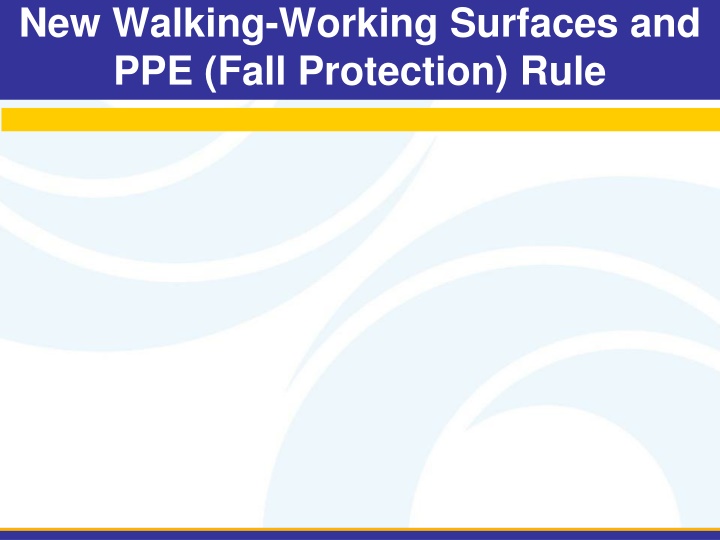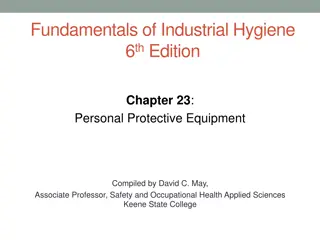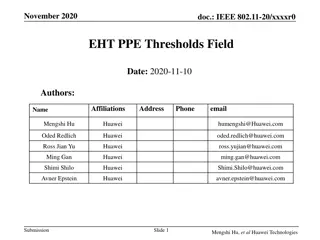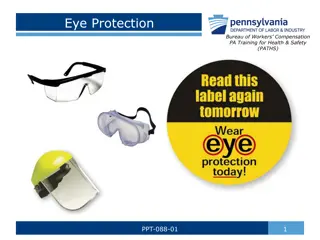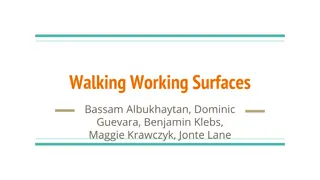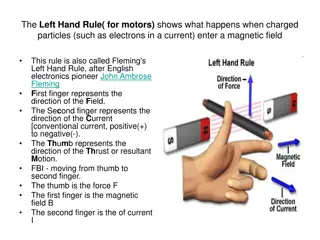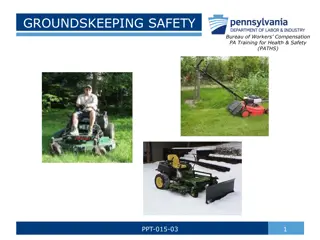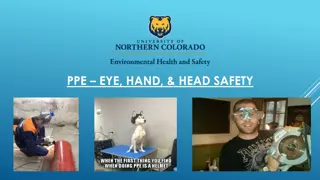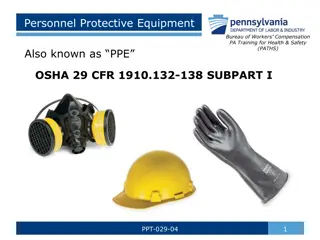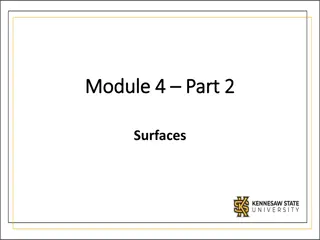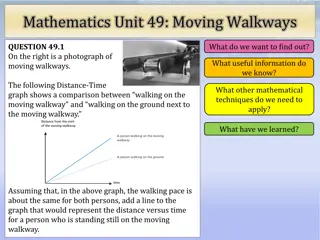New Walking-Working Surfaces and PPE (Fall Protection) Rule
This content discusses the new Walking-Working Surfaces and PPE (Fall Protection) Rule, its purpose, impact on the industry, benefits, organization of subpart D, and details of specific sections within the rule like general requirements, ladders, and training criteria. The rule aims to enhance workplace safety, prevent fatalities and injuries, and ensure compliance with OSHA standards.
Download Presentation

Please find below an Image/Link to download the presentation.
The content on the website is provided AS IS for your information and personal use only. It may not be sold, licensed, or shared on other websites without obtaining consent from the author.If you encounter any issues during the download, it is possible that the publisher has removed the file from their server.
You are allowed to download the files provided on this website for personal or commercial use, subject to the condition that they are used lawfully. All files are the property of their respective owners.
The content on the website is provided AS IS for your information and personal use only. It may not be sold, licensed, or shared on other websites without obtaining consent from the author.
E N D
Presentation Transcript
New Walking-Working Surfaces and PPE (Fall Protection) Rule
Purpose of the New Rule To update the outdated subpart D standard, incorporating new technology and industry practices To increase consistency with OSHA s construction standards (CFR 1926 subparts L, M, and X) To add new provisions to subpart I that set forth criteria requirements for personal fall protection equipment 2
Who is Affected? OSHA estimates 6.9 million general industry establishments employing 112.3 million workers will be affected 3
Benefits According to BLS data, slips, trips, and falls are a leading cause of workplace fatalities and injuries in general industry OSHA estimates the new rule will prevent 29 fatalities and 5,842 injuries annually Net benefits - $309.5 million/year (Monetized benefits annual costs) 4
Organization of Subpart D 1910.21 Scope, Application and Definitions 1910.22 General Requirements 1910.23 Ladders 1910.24 Stepbolts and Manhole Steps 1910.25 Stairways 1910.26 Dockboards 1910.27 Scaffolds and Rope Descent Systems 1910.28 Duty to Have Fall Protection 1910.29 Fall Protection Systems Criteria and Practices 1910.30 Training Requirements
1910.21 1910.21 Scope and definitions Consolidates definitions into one section Adds new definitions to provide clarity 6
1910.22 1910.22 General Requirements Maintains housekeeping provisions Walking-working surfaces must be designed to meet their maximum intended load, free of recognized hazards, and routinely inspected Repairs to be done, or overseen, by competent person 7
1910.23 1910.23 Ladders. Consolidates and simplifies rules intogeneral requirements, portable ladders, fixed ladders, and mobile ladder stands Requires inspection before use Fixed Ladders Portable Ladders and Step Stools 8
1910.23 (cont) Updates and makes rule consistent with current national consensus standards Mobile Ladder Stand Mobile Ladder Stand Platform 9
1910.24 1910.24 Stepbolts and manhole steps Step%252520Bolts Moves stepbolt criteria from OSHA s Telecommunication Standard to Walking-Working Surfaces Makes design, inspection, and maintenance requirements consistent with national consensus standards Step bolts on pole 10
1910.25 1910.25 Stairways Adds design and use criteria for spiral stairs, ship stairs, and alternating tread- type stairs Updates design criteria for stairs and landings, consistent with national consensus standards 11
1910.26 1910.26 Dockboards Updates requirements for dockboards Adds design and construction requirements to prevent equipment from going over the dockboard edge aluminum dock boards dock boards 12
1910.27 1910.27 Scaffolds and Rope Descent Systems (RDS) Requires that employers using scaffolds follow the construction standard Adds provision allowing use of RDS, which codifies a 1991 OSHA memo allowing RDS Requires certification of anchorages starting 1 year after final rule published Requires RDS have separate fall arrest system 13
1910.28 1910.28 Duty to have fall protection and falling object protection Consolidates general industry fall protection requirements into one section Makes requirements and format consistent with construction standard Incorporates new technology that is consistent with national consensus standards Gives employers flexibility to use the system that works best to protect workers in their situation 15
1910.29 1910.29 Fall protection systems criteria Specifies design and installation requirements of each fall protection system available to employers including: Guardrails Stair rails Designated areas Safety nets Covers Cages and wells Ladder safety systems Toeboards
1910.30 1910.30 Training Adds training and retraining requirements addressing fall hazards and equipment hazards Requires employers make training understandable to workers 17
1910.140 1910.140 Personal Protective Equipment (Personal Fall Protection Systems) Adds definitions for personal fall protection systems Adds new section on system and use criteria for: Personal fall protection equipment (e.g., lanyards, ropes, D-rings, harnesses) Personal fall arrest systems Travel restraint systems Work positioning systems 18
Personal Fall Protection Work Positioning Travel Restraint Personal Fall Arrest 19
Major Changes Fall Protection Flexibility Updated Scaffold Requirements Phase-in of ladder safety systems or personal fall arrest systems on fixed ladders Phase-out of qualified climbers on outdoor advertising structures Rope descent systems Adds requirements for personal fall protection equipment (final 1910.140) Adds training requirements 20
Main Effective Dates Rule overall: January 17, 2017 Training: 6 months after publication Building anchorages for RDS: 1 year after publication Fixed ladder fall protection: 2 years after publication Installation of ladder safety system or personal fall arrest system on fixed ladders: 20 years after publication 21
Compliance Assistance Resources OSHA s new webpage on subparts D&I: www.osha.gov/walking-working-surfaces/index.html Fact sheets FAQs 22
